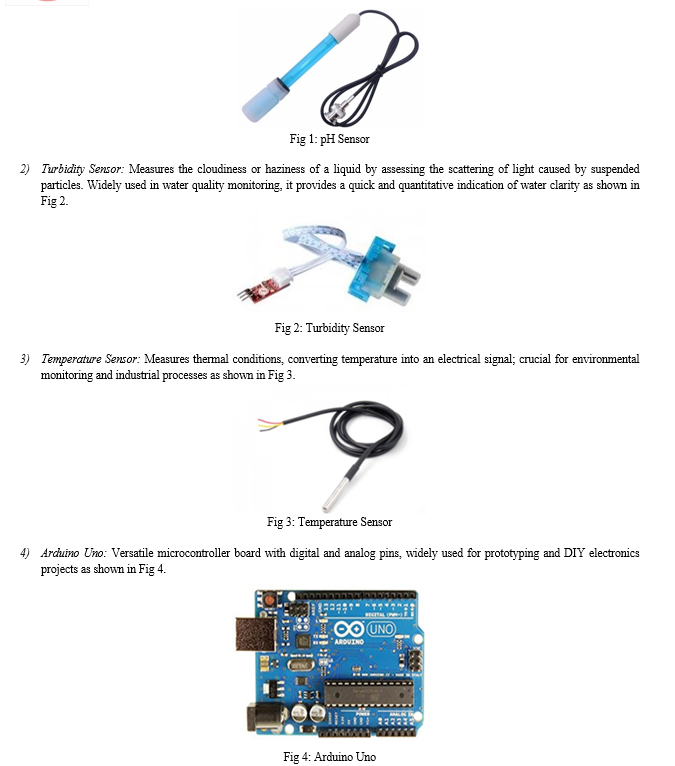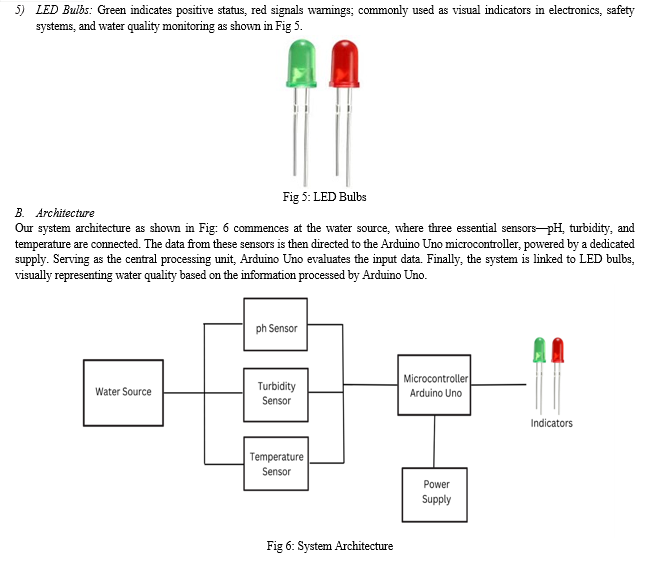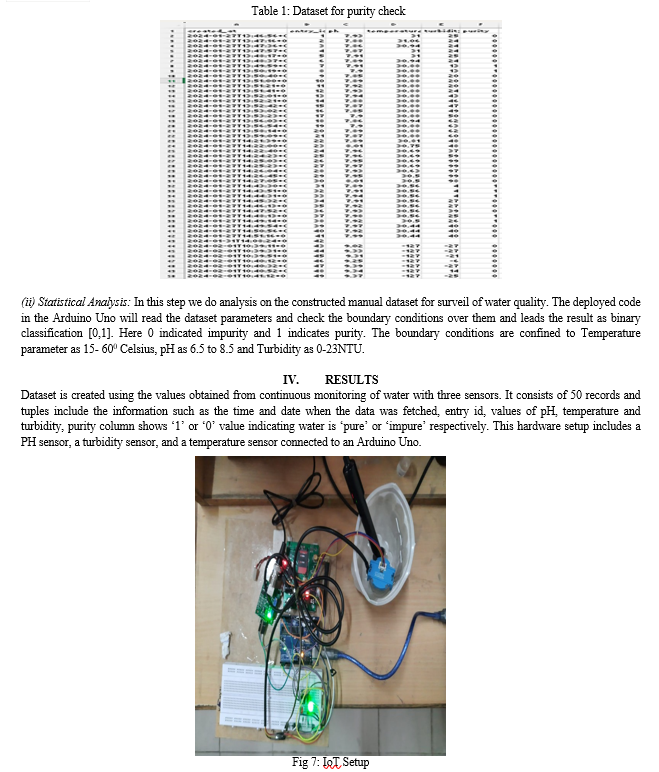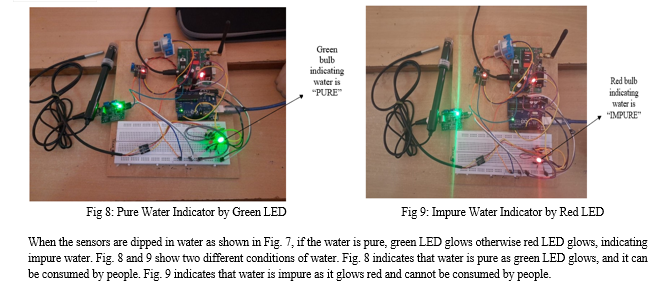Ijraset Journal For Research in Applied Science and Engineering Technology
- Home / Ijraset
- On This Page
- Abstract
- Introduction
- Conclusion
- References
- Copyright
An IoT- based Measure Guage for Surveil of Water Quality by Parametric Quantity
Authors: Preeti Nutipalli, Gella Chaitanya Venkata Sai, Gundu Abhinaya, Kota Chandini Manozna, Lodagala Hema Sai, Raghavendra Anurag Setamraju
DOI Link: https://doi.org/10.22214/ijraset.2024.59148
Certificate: View Certificate
Abstract
The document highlights the pressing need to address water-related challenges through innovative approaches, particularly by integrating IoT technology for water quality monitoring. Emphasizing the critical importance of safe drinking water, it proposes an IoT-based framework for continuous water quality assessment. This framework utilizes specific sensors to measure key parameters like turbidity, pH, and temperature, with microcontrollers processing the data for transmission to an Arduino Uno board. Real-time communication enables timely sharing of crucial information with stakeholders, facilitating proactive water resource management. The system determines water drinkability based on compiled data and provides a visual representation for easy interpretation by non-experts. Overall, the integration of IoT offers a comprehensive solution, ensuring safe water consumption and community engagement in water quality management, essential for securing sustainable water resources.
Introduction
I. INTRODUCTION
The Internet of Things (IoT) represents a transformative paradigm in the realm of technology, creating a vast interconnected network of devices that communicate and exchange data seamlessly. At its core, IoT is a framework where everyday objects, from household appliances to industrial machinery, are embedded with sensors, actuators, and communication capabilities. These devices collect and share data, enabling them to interact intelligently with each other and their surroundings. IoT's primary strength lies in its ability to gather real-time information from diverse sources, fostering enhanced decision-making and efficiency across various sectors. This interconnected ecosystem has found applications in smart homes, healthcare, agriculture, transportation, and industry, fundamentally altering the way we live and work. The proliferation of IoT devices has ushered in an era of unparalleled connectivity, where data-driven insights drive innovation. This connectivity extends beyond traditional computing devices to include a myriad of physical objects, contributing to the concept of a "smart" world. However, this interconnectedness also raises concerns about security, privacy, and the ethical use of data. As IoT continues to evolve, its impact on industries, economies, and daily life is undeniable. The promise of improved efficiency, resource optimization, and enhanced user experiences positions IoT as a transformative force, reshaping the landscape of technology and connectivity in profound ways. The integration of the Internet of Things (IoT) holds immense potential in addressing and resolving water purity concerns. IoT can revolutionize water quality monitoring by providing real-time data and intelligent solutions for water treatment and distribution. IoT-enabled sensors can be strategically deployed in water sources, treatment plants, and distribution networks to continuously monitor key parameters such as turbidity, pH levels, and temperature. These sensors transmit data in real time, allowing for prompt detection of any deviations from water quality standards. This timely information empowers water management authorities to proactively address contamination issues, minimizing the risk of distributing impure water to consumers. Furthermore, IoT facilitates predictive analytics, enabling the identification of potential contamination sources and the implementation of preventive measures. Machine learning algorithms can analyze historical data to predict water quality trends and assess the effectiveness of different treatment methods, optimizing the overall water purification process. In addition to monitoring, IoT contributes to efficient water management. Smart meters equipped with IoT capabilities can monitor water consumption patterns, detect leaks, and optimize water distribution networks. This ensures the equitable distribution of clean water and reduces wastage. Moreover, IoT-based solutions enable remote control and automation of water treatment processes. This not only enhances operational efficiency but also ensures that treatment parameters are consistently met, maintaining water quality standards. In conclusion, IoT emerges as a transformative tool in ensuring water purity by providing real-time monitoring, predictive analytics, and efficient management of water resources. Its ability to gather and analyze data and empowers authorities to take proactive measures, safeguarding the quality of water.
The contributions that are carried out in the work are:
- Ph sensor, turbidity sensor, and temperature sensor are connected to the Arduino Uno.
- Readings were analyzed in Arduino Uno, and purity was determined.
- If the water is pure green LED glows otherwise red LED glows indicating impure water.
The remaining part of work is carried out by 5 Sections as: Section 2 shows the related work, Section 3 describes the methodology and implementation, Section 4 displays the experimental results, lastly Section 5 includes conclusion.
II. LITREATURE REVIEW
The authors propose an IoT-based water quality monitoring model using Arduino technology to measure parameters like temperature and pH. They employ a fast forest binary classifier for categorizing water samples and integrate a .NET platform for data processing, ensuring compliance with WHO standards for water safety. This system combines IoT, Arduino, classifiers, and .NET for effective water quality monitoring [1]. Raji, Thasleena, and Shahzad propose a real-time sensor-based water quality monitoring system to overcome traditional testing limitations. Sensors measure pH, conductivity, temperature, and turbidity, with Arduino facilitating data collection and transmission to an Android app for remote monitoring. This approach offers a cost-effective and efficient solution compared to manual methods [2]. Sabari, Aswinth, Karthik, and Bharathkumar tackle contaminated drinking water affecting millions by leveraging IoT for real-time monitoring. Their proposed model integrates sensors, Arduino, and cloud technology to ensure continuous water quality assessment, promptly detecting contaminants to prevent disease outbreaks. This study aims to develop an efficient IoT-based system for real-time data collection and analysis, crucial for addressing waterborne diseases [3]. Krishna et al. propose a water parameter monitoring system centered around the multi-parameter sensor, EXO Sonde, capable of measuring over 20 parameters. Data is transmitted to a server and visualized through a web user interface using a layered architecture. Global System for Mobile Communications (GSM) facilitates communication between nodes [4]. Kumar, Ganjikunta Raj, et al. integrate pH, turbidity, and temperature sensors with Node MCU for groundwater pollution monitoring. The model assigns unique token IDs to sensors and includes water level checks, automatically stopping the pump motor at 100% water level to alert authorities about contamination [5]. Haque, Halima, et al. focus on assessing water quality for general use, examining parameters like pH, turbidity, temperature, dissolved oxygen, and conductivity. Their system employs Zigbee protocol for low-power communication, utilizing a central controller to manage sensor nodes, cluster head nodes, and network gateways through a gateway algorithm [6]. Sanya, Waheed Muhammad, Alawi, and Issah Eugenio's model monitors pH, turbidity, and temperature, transmitting data to a cloud server via LoRa technology. The server, equipped with Matlab, analyzes and visualizes data for water quality assessment, accessible to users through a web interface [7]. Manoj, M., et al proposed a model which is an effective IoT based water quality monitoring system for fish ponds. This paper records ph, temperature, DO, Nitrogen and sends to aurdino for processing. It alerts the user in web application [8]. Ismail A. Adeleke's model utilizes IoT, ML, and cloud technologies for water quality monitoring. Sensors in drinking water stations transmit data wirelessly to Google Cloud, where ML algorithms predict water quality in real-time. Additionally, a control mechanism treats water if ORP or pH levels are dangerously low [9]. Hemdan et al. propose an IoT-enabled water quality unit for any water source entrance, focusing on the Water Quality Index (WQI). Their study compares LSTM and Facebook Prophet models for forecasting water quality, with Facebook Prophet outperforming LSTM [10].
III. RESEARCH METHODOLOGY
The proposed model presents a resilient approach to monitor water quality through IoT, facilitating the detection of compromised drinking water, monitoring sensor positions, and enhancing healthcare administration and decision-making procedures. The setup includes a pH sensor, turbidity sensor, and temperature sensor to assess diverse factors impacting water purity. Interconnections are established between these sensors and a microcontroller. The Arduino Uno microcontroller evaluates water quality, determining whether it is pure or impure, and activates indicator bulbs accordingly. In the case of pure water, the system illuminates a green bulb, while impure water triggers the activation of a red bulb. This comprehensive system not only identifies potential contamination in drinking water but also employs a user-friendly visual indicator to communicate water quality, aiding in efficient decision-making and management of healthcare resources.
A. IoT Devices
1) pH Sensor: Determines acidity or alkalinity in a solution, vital for water quality assessment and various analytical applications as shown in Fig 1.


C. Implementation
To set up the system, begin by connecting the positive (Vcc) wires of the pH, turbidity, and temperature sensors to the 5V pin on the breadboard. Then, link the negative (Ground) wires of these sensors to the negative (Ground) rail on the breadboard. Next, attach the data pin of the temperature sensor to digital pin 8 on the Arduino Uno, while connecting the data pin of the pH sensor to analog pin A3 and the data pin of the turbidity sensor to analog pin A5 on the Arduino Uno. For the LED bulbs, connect their positive (Anode) wires to analog pins 12 and 13 on the breadboard, and link their negative (Cathode) wires to the negative (Ground) rail on the breadboard. Ensure the GND pin of the Arduino Uno is connected to the negative (Ground) rail on the breadboard. Finally, power the Arduino Uno by connecting its USB port to a power supply, such as a computer. Likewise, upload code to the Arduino Uno using the Arduino IDE software. The further stages of implementing the application are described in step wise as follows:
- Data Collection Sources: In this step we collect the details of sensors readings from the water and construct the dataset manually as shown in Table 1 with different attributes such as pH, Temperature, Turbidity, Date & Time and purity. Using the first three parameters we determine the purity of water basing on boundary conditions.


Conclusion
In the culmination of our water quality monitoring project, the integration of IoT technologies, including pH, turbidity, and temperature sensors, presents a sophisticated solution for contemporary water resource challenges. Positioned at the water source, these sensors provide real-time data, feeding into the central processing unit, an Arduino Uno microcontroller. This versatile microcontroller, powered by a dedicated supply, efficiently analyzes the incoming data, interpreting pH levels, turbidity, and temperature to assess water quality comprehensively. The system\'s architecture ensures a seamless flow of information, enabling timely responses to changes in water quality. The Arduino Uno then connects to LED bulbs, serving as immediate visual indicators. A green bulb signals safe water, meeting desired standards, while a red bulb illuminates in the presence of deviations, indicating potential concerns. This user-friendly visual representation enhances transparency and community engagement, allowing individuals to easily interpret and respond to water quality status. Beyond meeting the immediate need for real-time monitoring, our project contributes to sustainable and informed water management practices, addressing the complexities of contemporary water challenges and ensuring the safety of water resources for the present and future.
References
[1] 2019-Mukta, Monira; Islam, Samia; Barman, Surajit Das; Reza, Ahmed Wasif; Hossain Khan, M Saddam (2019). [IEEE 2019 IEEE 4th International Conference on Computer and Communication Systems (ICCCS) - Singapore (2019.2.23-2019.2.25)] 2019 IEEE 4th International Conference on Computer and Communication Systems (ICCCS) - lot-based Smart Water Quality Monitoring System. (), 669–673. doi:10.1109/CCOMS.2019.8821742 [2] 2019-Raji, C. G., V. A. Thasleena, and Mohammed Shahzad. \"IOT based water quality monitoring with android application.\" 2019 Third International conference on I-SMAC (IoT in Social, Mobile, Analytics and Cloud)(I-SMAC). IEEE, 2019. [3] 2020-M, Sabari.; P, Aswinth.; T, Karthik.; C, Bharath kumar. (2020). [IEEE 2020 5th International Conference on Devices, Circuits and Systems (ICDCS) - Coimbatore, India (2020.3.5-2020.3.6)] 2020 5th International Conference on Devices, Circuits and Systems (ICDCS) - Water Quality Monitoring System Based on IoT (), 279–282. doi:10.1109/ICDCS48716.2020.243598 [4] Krishna, S., et al. \"loT based water parameter monitoring system.\" 2020 5th International Conference on Communication and Electronics Systems (ICCES). IEEE, 2020. [5] Kumar, Ganjikunta Raj, et al. \"Waste contamination in Water-A Real-time Water Quality Monitoring System using lot.\" 2021 International Conference on Computer Communication and Informatics (ICCC/). IEEE, 2021. [6] Haque, Halima, et al. \"IoT based water quality monitoring system by using Zigbee protocol.\" 2021 International Conference on Emerging Smart Computing and Informatics (ESCI). IEEE, 2021 [7] Sanya, Waheed Muhammad, Mahmoud A. Alawi, and Issah Eugenio. \"Design and development of Smart Water Quality Monitoring System Using IoT.\" Int. J. Adv. Sci. Res. Eng 8.03 (2022): 01-13. [8] Manoj, M., et al. \"State of the art techniques for water quality monitoring systems for fish ponds using iot and underwater sensors: A review.\" Sensors 22.6 (2022): 2088. [9] Adeleke, Ismail A., Nnamdi I. Nwulu, and Omolola A. Ogbolumani. \"A hybrid machine learning and embedded IoT-based water quality monitoring system.\" Internet of Things 22 (2023): 100774. [10] Hemdan, Ezz El-Din, et al. \"An efficient IoT based smart water quality monitoring system.\" Multimedia Tools and Applications (2023): 1-25.
Copyright
Copyright © 2024 Preeti Nutipalli, Gella Chaitanya Venkata Sai, Gundu Abhinaya, Kota Chandini Manozna, Lodagala Hema Sai, Raghavendra Anurag Setamraju. This is an open access article distributed under the Creative Commons Attribution License, which permits unrestricted use, distribution, and reproduction in any medium, provided the original work is properly cited.

Download Paper
Paper Id : IJRASET59148
Publish Date : 2024-03-19
ISSN : 2321-9653
Publisher Name : IJRASET
DOI Link : Click Here
 Submit Paper Online
Submit Paper Online

